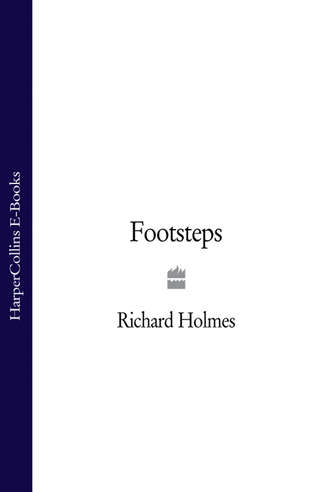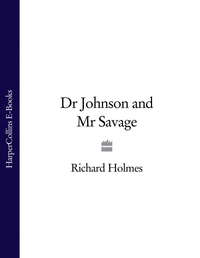
Полная версия
Footsteps
At Florac Stevenson again lunched at the inn, where he was received as something of a portent. “My knife, my cane, my sack, all my arrangements were cordially admired.” The village schoolmaster came in to question him, and the young innkeeper—unmarried, living with his sister—struck an amusing note: “‘Tout ce que vous avez est joli,’ said the young man, ‘et vous l’êtes’”—which Stevenson let pass with a smile. But again I sensed his hurry: he pressed on down the road towards Cassagnas—overtaken by that “black care” on his knapsack—and once again the dusk found him groping for a camp in the valley of the Mimente: “I slipped down to the river, which looked very black among its rocks to fill my can; and then I dined with good appetite in the dark, for I scrupled to light my lantern in the near neighbourhood of a house … All night, a strong wind blew up the valley and the acorns fell pattering over me from the oak.”
This was his penultimate night on the road—and peace fell from the stars, he says, on to his spirit “like a dew”. But he was much disturbed by the barking of a watch-dog from that nearby house, and the first hints of returning civilisation were upon him. “To a tramp like myself,” he noted, “the dog represents the sedentary and respectable world in its most hostile form. There is something of the clergyman or the lawyer in the engaging animal.”
I made a little fire among the rocks by the river, and slept in the doorway of an isolated barn. My diary notes “a solitary star below the door-lintel, a little rain, and an occasional blink of lightning over the oak trees”.
The same dog, the messenger of civilisation, woke Stevenson early on the morning of Wednesday, 2 October, and already beginning to think of the letters awaiting him at Alais he was packed and on the road for Cassagnas before the sun had slid into the valley. It was one of his longest day’s walks, he was clearly close to exhaustion—like Modestine—and his final journal entries are desultory.
At Cassagnas, “a black village on the mountainside”—again that note of drained colour—he dined with the local gendarme and a travelling merchant at the inn. There was some gossip of a renegade Catholic curé, who had given up his ministry and “taken to his bosom” the local schoolmistress; the villagers, though almost all Protestant, showed little sympathy for the man’s predicament, despite the fact that their own Protestant priests were allowed and indeed encouraged to marry. The general sentiment seemed to be that “it is a bad idea for a man to go back on his engagements”—even if it was such an unnatural one as Catholic celibacy. Stevenson remarks wryly that “perhaps the bad idea was to enter into them at the first” and continues with a brief, rather hazy passage about the “holy simplicity” of physical desires and needs. “The world gives liberally of things to eat; it is all over spouting fountains; and a man need not travel very far ere he finds a woman to whom his soul can cling. If he can but lay aside some dismal ascetic standards, and a few hollow aspirations …”
But he was pleased to find that both the policeman and the merchant were more than a little shocked to discover that he had been sleeping in the open. There was talk of wolves and thieves—“the English always have long purses”—and general head-shaking. To all Stevenson’s smiling and shrugging—” ‘God,’ said I, ‘is everywhere’”—the merchant replied in grave, flattering disapproval: “Cependant, coucher dehors!” and finally asked for one of Stevenson’s visiting cards, saying that “it would be something to talk about in the future, this donkey-driving, English amateur vagrant.” Stevenson was charmed to comply.
Without further delay, he then crossed back over the Mimente to the southern side of the valley and began to climb the ragged path that leads steeply up through “sliding stone and heather tufts” to the huge, long escarpment known as Mont Mars. It took him nearly all afternoon to get over the crest and discover the astonishing panorama of hills on the other side, dominated by the Plan de Fontmort where the Camisards fought their last, bloody and suicidal battle.
To me this was the single most impressive view of the entire journey. I scrawled wildly in my diary:
Like gasping for breath in a rolling blue sea of hills going southwards as far as the sky and further—being washed entirely away by it all—exalted and lonely as hell—stood on a rock of the heathery col drinking toast to RLS—tin cup held up to horizon—somewhere he must have heard—black cicadas exploding all round with shiny red wings in the sunlight.
Obscurely I felt that the whole trip “made sense beyond metaphor of explanation”, in that high, bright, windy place of the Cévennes. I lay for hours on my back in the heather watching the clouds troop endlessly and majestically overhead in the blue. If you were dead and buried, I thought, that is how life would go on around you; that is how Stevenson would see it. And of course I recited his epitaph, known by heart, to generations of English children like me:
Here he lies where he longed to be;
Home is the sailor, home from the sea,
And the hunter home from the hill.
Stevenson arrived on the edge of Mont Mars when it was already late in the afternoon. He was deeply moved too by the realisation that his journey must be near its end; he could not continue it much longer. “It was perhaps the wildest view of my journey; peak upon peak, chain upon chain of hills ran surging southward, channelled and guttered by winter streams, feathered from head to foot with chestnuts and here and there breaking out into a coronal of cliffs.” The sun was setting behind the Plan de Fontmort and the darkness was filling up the valleys. “Away across the highest peaks, to the south-west, lay Alais, my destination.” An old shepherd hobbling on a pair of sticks and wearing a black cap of liberty, “as if in honour of his neighbourhood to the grave”, directed him to the road for St Germain-de-Calberte.
Here Stevenson was to spend his final night, and his journal ends with a description of the long descent to the village, through high terraces of chestnut trees, as the dusk fell and the moon came up. The road glimmered white, “carpeted with noiseless dust”, and Stevenson drank mouthfuls of Volnay wine until he was no longer conscious of his limbs. He arrived just as the landlady of the inn was putting her chickens to bed. “The fire was already out and had, not without grumbling, to be rekindled; quarter of an hour later and I must have gone supperless to roost.”
He met no one on this last, light-headed stretch; but he heard a voice, the voice of a woman singing, somewhere below him through the rustling chestnut trees. In a sense, of course, it was Fanny’s voice, and he wished he could have responded. “I could barely catch the words, but there was something about a bel amoureux, a handsome lover. I wished I could take up the strain and answer her, as I went on my invisible woodland way. If a traveller could only sing, he would pay his way literally, it seems to me.”
In the Travels Stevenson gently elaborates on this last encounter, describing the song as “some sad, old, endless ballad” (was he thinking of Wordsworth’s “solitary highland lass” heard singing in the fields?) and wondering what he might have said to her: “Little enough; and yet all the heart requires. How the world gives and takes away, and brings sweethearts near only to separate them again into distant and strange lands; but to love is the great amulet which makes the world a garden; and ‘hope, which comes to all’, outwears the accidents of life …”
The following day, Thursday, 3 October, he took the carriage road over the Col de St Pierre to St Jean-du-Gard. Here Modestine was declared unfit to travel by the farrier, and Stevenson found his journey had come abruptly to an end. His relief is evident. He sold his “lady friend” for thirty-five francs, boxed up his belongings and caught the afternoon diligence—“now eager to reach Alais for my letters”. His envoi is light-hearted: “It was not until I was fairly seated by the driver, and rattling through a rocky valley with dwarf olives, that I became aware of my bereavement. I had lost Modestine. Up to that moment I had thought I hated her; but now she was gone—‘And oh! The difference to me!’” This time the reference is explicit, to Wordsworth’s Lucy poems. Stevenson adds mockingly that “being alone with a stage-driver” and four or five other passengers he wept openly for his loss.
I spent my last night under one of those huge spreading chestnut trees, off the old coaching road—now no more than a track—beyond St Germain-de-Calberte. I had walked along for an hour in the moonlight, after supper at the auberge, listening for the sounds of singing. I was tired and slept well, to be woken after six by a red squirrel skittering in the branches overhead. I immediately felt alone: Stevenson had departed. I cooked my last coffee with strange sensations of mixed relief and abandonment. Then as I packed up my rucksack a wild happiness filled me, and a sense of achievement. I had done it, I had followed him, I had made a mark. Very deliberately and self-consciously I stuck my bone-handled sheath-knife deep into the bark of the old chestnut, and left it there like a trophy.
I walked over the Col de St Pierre in six hours, and came down to St Jean-du-Gard, a modern market town on the high road between Ales and Millau, no longer in the magic département of Lozère. Suddenly I was back in civilisation. I had two beers at a café, one for Stevenson and one for Modestine, and seeing my silver ring and long hair the garçon addressed me charmingly throughout as “Monsieur Clochard”. Indeed I was no longer quite sure who I was, except a stranger back in the modern world like Rip van Winkle.
The sense of having been away, somewhere quite else, was extraordinarily strong: my first experience of biographer’s “time-warp”. I hitch-hiked home to my vine-farmers, in the south-east beyond Nîmes, riding in the open back of a big lorry carrying red Calor-gas cans. Facing backwards, my pack swaying at my feet, the cans clanging like sea-buoys, the wind plucking at Le Brun, I watched the dark-brown line of the Cévennes drop below the north-west horizon like “a sea-coast in Bohemia”. My head was full of poems I would write.
5
Stevenson published his Travels with a Donkey some six months later, in the spring of 1879. He spent several weeks working on it during the autumn, in Cambridge, at Sidney Colvin’s rooms in Trinity; and then, over Christmas, at home in Edinburgh. All this time he had no news of Fanny in San Francisco. His aim was to expand his original journal from some twenty thousand words to a small volume of about double that length. To this purpose he filled in topographical details from guide-books and added the Camisard history from Napoléon Peyrat and other sources; he carefully rewrote his religious reflections (partly so as not to shock his father) and rehandled the encounters with the monks and the priest at La Trappe, and the old Plymouth Brother at Florac; finally, he deleted or generalised the amorous reflections that were originally written with Fanny in mind—so effectively that even a recent modern biographer has concluded that “there is only one passage in which we are made aware of the fact that he was missing Fanny intensely”.
The book was dedicated to Sidney Colvin, in one of those warm, enigmatic public letters of introduction that Stevenson could write so well, hinting at Romantic mysteries and philosophies but leaving everything half-explained, half in shadow:
The journey which this little book is to describe was very agreeable and fortunate for me. After an uncouth beginning, I had the best of luck in the end. But we are all travellers in what John Bunyan calls this wilderness of the world—all, too, travellers with a donkey: and the best that we can find in our travels is an honest friend … Every book is, in an intimate sense, a circular letter to the friends of him who writes it. They alone take his meaning; they find private messages, assurances of love, and expressions of gratitude, dropped at every corner. The public is but a generous patron who defrays the postage …
In private Stevenson was much more explicit, writing to cousin Bob in June 1879, in his downright and devil-take-it style. He makes no pretences as to who is at the centre of the work:
My book is through the press. It has good passages, I can say no more. A chapter called ‘The Monks’, and then ‘A Camp in the Dark’, a third, ‘A Night in the Pines’. Each of these has I think some stuff in the way of writing. But lots of it is there protestations to F., most of which I think you will understand. That is to me the main thread of interest. Whether the damned public—But that’s all one. I’ve got 30 quid for it, and should have had 50.
His preoccupation with money had a simple explanation. For he had at last secretly determined to rejoin Fanny in San Francisco, and once her divorce from Sam Osbourne was through to marry her. Two months later, on 7 August 1879, he bought a second-cabin steerage ticket to New York for eight guineas, and without telling his parents embarked on his second pilgrimage: the greatest adventure of his life.
For the “damned public” the book has remained essentially an exercise in style, “agreeably mannered”, and a model of polite essay-writing for generations of English and Scottish schoolchildren. My own little brown-backed copy, printed in 1936, still gives as likely essay-subjects, in an appendix after the text, such lines of enquiry as: “What are the respective advantages of a walking, cycling, motoring, and caravaning tour?” And, “What is Stevenson’s religious position, and can a charge of affectation be made against it?” However, I do like one suggestion: “Put yourself in Modestine’s place, and write a character study of your Master.” It might lead on to deeper matters.
For Stevenson himself there remains no doubt now in my own mind that the whole Cévennes experience was a kind of initiation ceremony: a grappling with physical hardships, loneliness, religious doubts, the influence of his parents, and the overwhelming question of whether he should take the enormous risk of travelling to America and throwing his life in with Fanny’s—“for richer, for poorer; in sickness and in health”. In the desperate summer months of 1879, immediately prior to his departure for New York, the memory of the trip was obviously much in his mind. He wrote to a friend: “I can do no work. It all lies aside. I want—I want—a holiday; I want to be happy; I want the moon or the sun or something. I want the object of my affections badly anyway; and a big forest; fine, breathing, sweating, sunny walks; and the trees all crying aloud in the summer wind and a camp under the stars.”
So the pilgrimage begun at Le Monastier ended six thousand miles away in a honeymoon on the wooded hills of the Pacific coast of California. But that is another story, as eventually told in The Silverado Squatters.
For me, the Cévennes was a different initiation. I embarked on it, and finished it, in all innocence from a literary point of view. It never crossed my mind that I might write about Stevenson; or that my diary should be anything more than a “route-journal”, a record of my road and camps. If I wrote anything at all, I thought, it would be poems about walking, swimming, climbing hills and sleeping under the stars. But what happened was something quite other, something almost entirely unexpected. Instead of writing poems I wrote prose meditations. These concerned not so much the outward physical experiences of my travels but inward mental ones that were often profoundly upsetting. The full record of my black depressions, intense almost disabling moments of despair, and childish weeping fits, still seems inexplicable and embarrassing. The corresponding moments of intoxication and mad delight are still vivid to me twenty years afterwards, so that my pulse-rate increases when I write about them, even now. But all these inward emotions were concentrated and focused on one totally unforeseen thing: the growth of a friendship with Stevenson, which is to say, the growth of an imaginary relationship with a non-existent person, or at least a dead one.
In this sense, what I experienced and recorded in the Cévennes in the summer of 1964 was a haunting. Nothing of course that would make a Gothic story, or interest the Society for Psychical Research; but an act of deliberate psychological trespass, an invasion or encroachment of the present upon the past, and in some sense the past upon the present. And in this experience of haunting I first encountered—without then realising it—what I now think of as the essential process of biography.
As far as I can tell, this process has two main elements, or closely entwined strands. The first is the gathering of factual materials, the assembling in chronological order of a man’s “journey” through the world—the actions, the words, the recorded thoughts, the places and faces through which he moved: the “life and letters”. The second is the creation of a fictional or imaginary relationship between the biographer and his subject; not merely a “point of view” or an “interpretation”, but a continuous living dialogue between the two as they move over the same historical ground, the same trail of events. There is between them a ceaseless discussion, a reviewing and questioning of motives and actions and consequences, a steady if subliminal exchange of attitudes, judgments and conclusions. It is fictional, imaginary, because of course the subject cannot really, literally, talk back; but the biographer must come to act and think of his subject as if he can.
The first stage of such a living, fictional relationship is in my experience a degree of more or less conscious identification with the subject. More or less, because the real elements of self-identification are often much more subtle and subliminal than one originally thinks. This, strictly speaking, is pre-biographic: it is a primitive form, a type of hero- or heroine-worship, which easily develops into a kind of love affair. Looking back at the Cévennes, I can now see that I went straight into that phase with Stevenson, passionately identifying with what I saw as his love of bohemian adventuring, getting out “on the road”, and sharing with him his delight in all things French, original, eccentric. I saw him, naively, as a direct predecessor of figures like Jack Kerouac—though the European Kerouac, the Kerouac of Lonesome Traveller, a bit lost and a bit uncertain of himself, not the roaring American romantic of On the Road. The Kerouac who, at the very end of his drunken career, comes back to France looking for his lost family roots in Brittany, searching for the Lebris de Kéroack in Satori in Paris.
My real reasons for self-identification I now see as rather different: they involved the confrontation with religious upbringing and lost faith, Stevenson’s Calvinism having some equivalence to my Catholicism. They also involved a natural struggle to free myself from parental influences—benign ones, but nevertheless encroaching. Hence I suspect the powerful note struck by Stevenson’s exploration of the “dream childhood” theme, the poetry of homesickness—of travelling far away over blue hills and brown rivers, only to find yourself once more back on the final wooded ridge above the natal valley, the small boy wanting to come home.
This form of identification or self-projection is pre-biographic and in a sense pre-literate: but it is an essential motive for following in the footsteps, for attempting to re-create the pathway, the journey, of someone else’s life through the physical past. If you are not in love with them you will not follow them—not very far, anyway. But the true biographic process begins precisely at the moment, at the places, where this naive form of love and identification breaks down. The moment of personal disillusion is the moment of impersonal, objective re-creation. For me, almost the earliest occasion was that bridge at Langogne, the old broken bridge that I could not cross, and the sudden physical sense that the past was indeed “another country”.
The past does retain a physical presence for the biographer—in landscapes, buildings, photographs, and above all the actual trace of handwriting on original letters or journals. Anything a hand has touched is for some reason peculiarly charged with personality—Thomas Hardy’s simple steel-tipped pens, each carved with a novel’s name; Shelley’s guitar, presented to Jane Williams; Balzac’s blue china coffee-pot, with its spirit-heater, used through the long nights of Le Père Goriot and Les Illusions Perdues; other writers’ signet rings, worn walking-sticks, Coleridge’s annotated books, Stevenson’s flageolet and tortoise-shell “Tusitala” ring. It is as if the act of repeated touching, especially in the process of daily work or creation, imparts a personal “virtue” to an inanimate object, gives it a fetichistic power in the anthropological sense, which is peculiarly impervious to the passage of time. Gautier wrote in a story that the most powerful images of past life in the whole of Pompeii were the brown, circular prints left by drinkers’ glasses on the marble slabs of the second-century taverna.
But this physical presence is none the less extremely deceptive. The material surfaces of life are continually breaking down, sloughing off, changing, almost as fast as human skin. A building is restored, a bridge is rebuilt or replaced, a road is widened or rerouted, a forest is cut down, a wooded hill is built over, a village green becomes a town centre. Stevenson’s La Trappe had been burnt down, redesigned and rebuilt; many of his donkey-tracks had become tarred roads; his wild upland heaths had been planted over; and even his terraces of deep chestnut trees had been replaced by the commercial foresting of young pines.
The well-meaning attempt to conserve or recover the past can be more subtly destructive. Since the centenary of Stevenson’s Travels I am told the whole route has been marked out, by the local Syndicats d’Initiative, with a series of blazed stakes which lead the pilgrim from one picturesque point de vue to the next, and bring him safely down each evening to some recommended hotel, Carte Touristique, hot bath, and Souvenirs Cévenols. I have not had the heart to go back and see.
Beyond this sense of physical presences growing upon the biographer—which includes the whole aura of personal body influence, the sound of Stevenson’s voice, his particular loose-limbed gait, his mixture of frail boniness and hectic energy, the large mobile brown eyes, the quick thin wrists and ankles, the smell of tobacco and cognac and cologne and sweaty Scottish tweed mixed with the rank odour of Modestine—there is the growing awareness of psychological complication.
This is the second factor that awakens the necessary objectivity of the biographer. My gradual discovery of Fanny Osbourne, and her hidden importance in Stevenson’s journey, made me realise how Stevenson fitted into the enormously intricate emotional web of other people’s lives. The single subject of biography is in this sense a chimera, almost as much as the Noble Savage of Jean-Jacques Rousseau, living in splendid asocial isolation. The truth is almost the reverse: that Stevenson existed very largely in, and through, his contact with other people: his books are written for his public; his letters for his friends; even his private journal is a way of giving social expression—externalising—his otherwise inarticulated thoughts. It is in this sense that all real biographical evidence is “third party” evidence; evidence that is witnessed. Just as the biographer cannot make up dialogue, if he is to avoid fiction; so he cannot really say that his subject “thought” or “felt” a particular thing. When he uses these forms of narration it is actually a type of agreed shorthand, which must mean—if it means anything factual—that “there is evidence from his letters or journals or reported conversations that he thought, or that he felt, such-and-such a thing at this time …” In this way the biographer is continually being excluded from, or thrown out of, the fictional rapport he has established with his subject. He is like the news reporter who is told something in confidence, “off the record”, and then can do nothing about it until he has found independent evidence from other sources. His lips are sealed, his hands tied. Otherwise he is dishonourable and prosecutable, not only in the courts of Justice, but in the courts of Truth as well.








